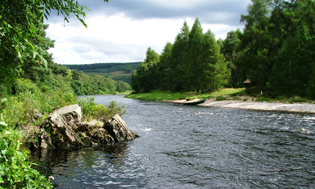 In common with many other Scottish Rivers this year, 2013 has been a challenging year for Salmon fishing on the River Spey. A long, cold winter, followed by drought conditions throughout the summer, has presented anglers with difficult conditions. Nonetheless, on a positive note, anglers are returning more fish and juvenile fish are thriving.
In common with many other Scottish Rivers this year, 2013 has been a challenging year for Salmon fishing on the River Spey. A long, cold winter, followed by drought conditions throughout the summer, has presented anglers with difficult conditions. Nonetheless, on a positive note, anglers are returning more fish and juvenile fish are thriving.
The low water throughout the summer has created challenging conditions for anglers, with water levels dropping close to those seen during the 1976 drought. In a river as important as the Spey which, in addition to salmon, also supports freshwater pearl mussels, a thriving whisky industry and an expanding human population, these low flows have highlighted the absolute requirement to maintain water quality and quantity. They have also highlighted the reasons behind the Board’s decision to object to Scottish & Southern Energy’s proposals to take yet more water from the Truim and the Tromie, important tributaries of the River Spey, and why these proposals are so inappropriate for the wider ecology.
The Spey Fishery Board has reported catches of Salmon and Grilse for the 2013 season (from the 11th February to the end of September) as 5,780, in comparison to the 7,490 caught for the same period last year.
Despite the challenging conditions, though, anglers have responded positively by returning more fish caught than ever before. Throughout the season, 88% of all Salmon and Grilse caught were released, an increase on the 85% returned for the same period last year. Furthermore, the release rate for the Spring Salmon, traditionally caught between February and the end of April, was a highly impressive 92%. SFB Director Roger Knight said, “Release rates in the Spey are highly creditable. They are testimony to the conservation-minded attitudes that are prevalent on the Spey and they are particularly relevant as a means of compensating for the poor survival rate of Salmon at sea. The Board is grateful to all of the ghillies, whom it recognises have played such an active role in persuading so many anglers to co-operate with the policy”.
It appears from anecdotal evidence from other Rivers, that Marine Survival is poor and this sadly will have had a depressing effect on the numbers of returning fish.
Nonetheless, earlier this year the Board’s scientific research team also revealed positive news, following its regular electro-fishing programme which it undertakes each summer to monitor the numbers of juvenile fish. Many areas along the mainstem of the River Spey have been monitored, as well as the Rivers Avon, the Dulnain and the Truim, all of which are important tributaries of the Spey. SFB Biologist Brian Shaw said, “Juvenile salmon and trout counts have been good in all areas, and at a level not seen in the last six years. Salmon parr numbers in the mainstem have doubled when compared to last year.”
